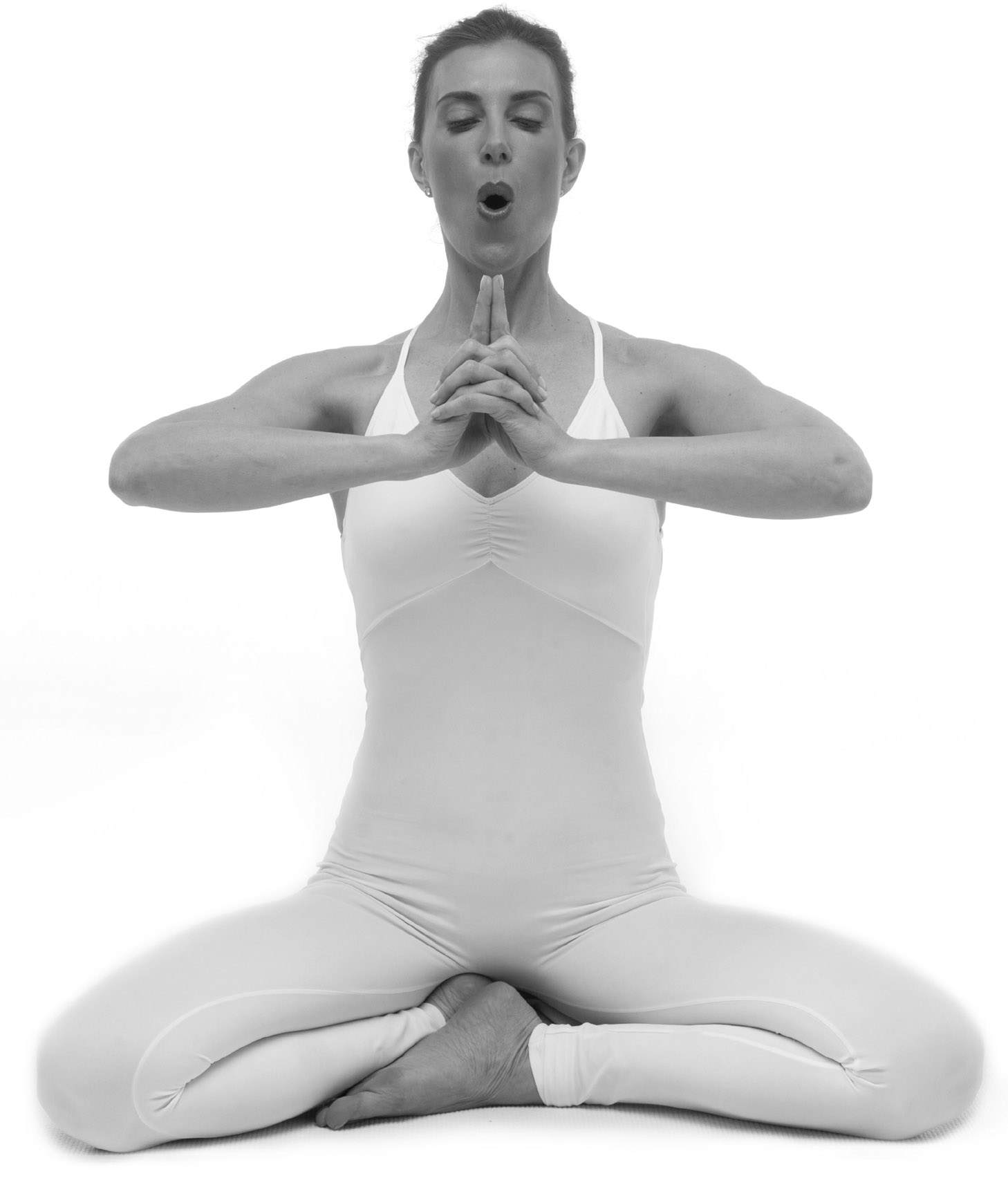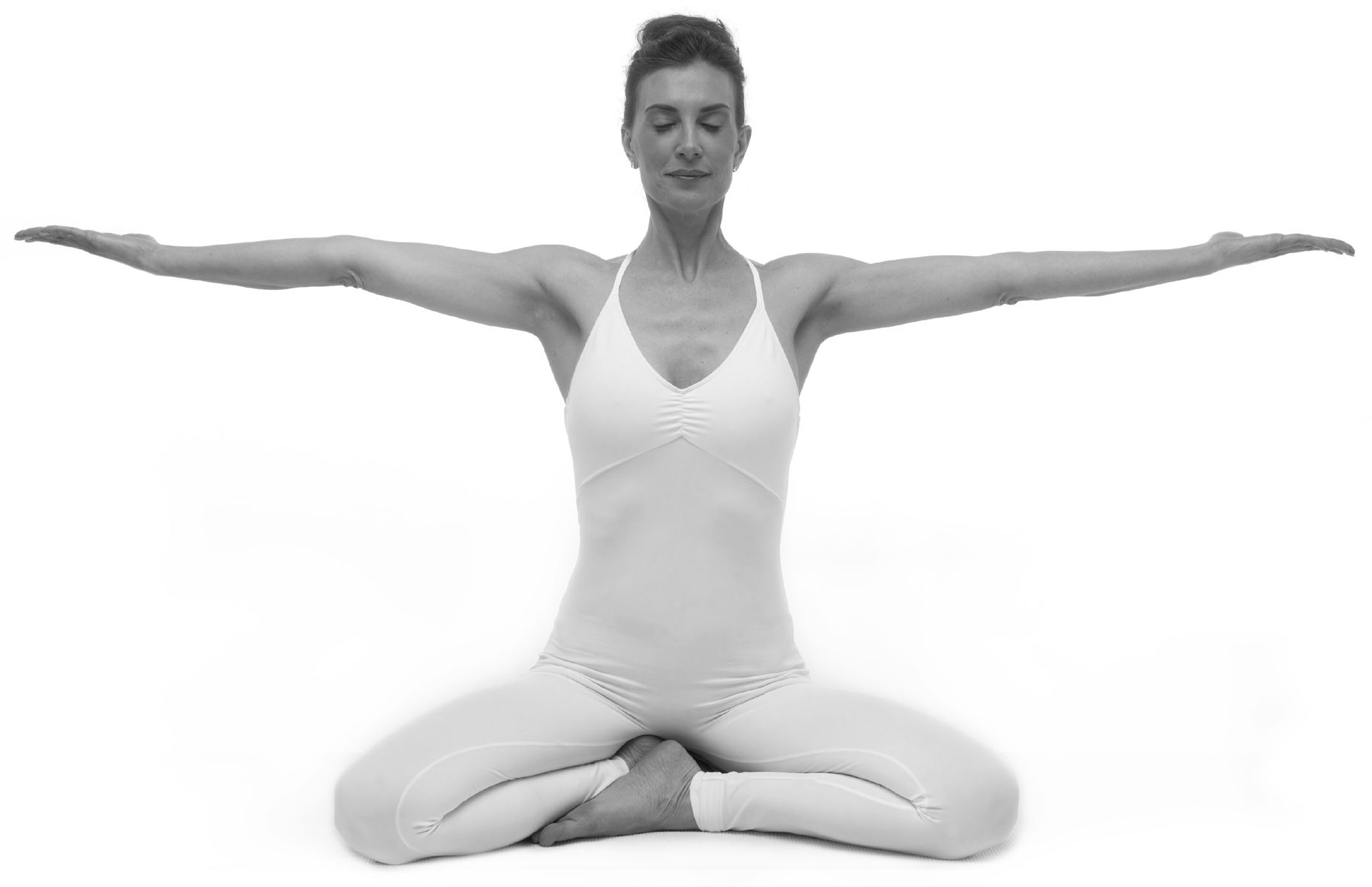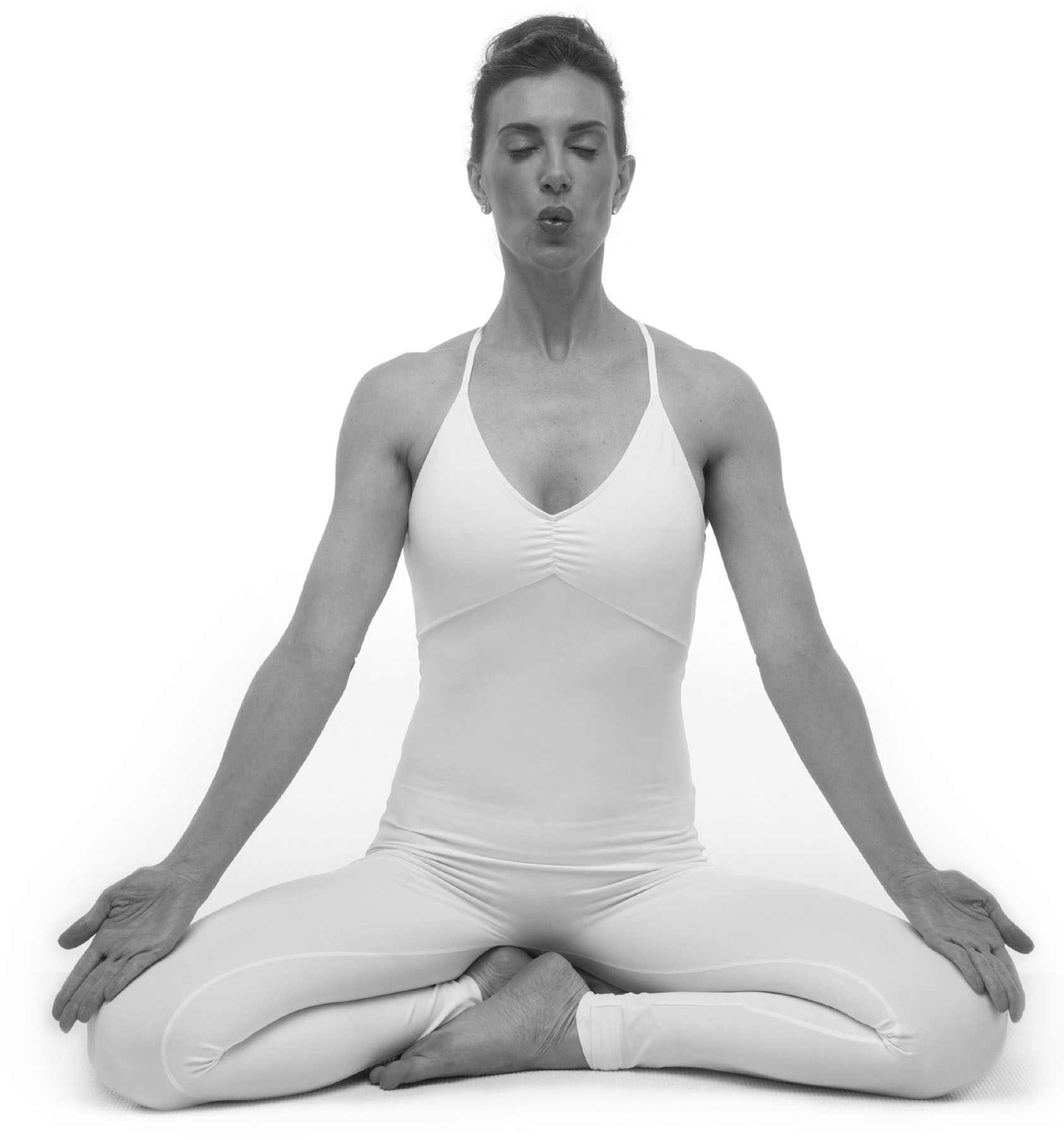4 BREATHING FOR TRANSFORMATION
When the pranic bodies are augmented, all bodies are perfectly in order. Because between you and God there is only one link and that is the breath.
YOGI BHAJAN
WE WOULD LIKE YOU TO release the concept that you are breathing air and embrace the concept that you are breathing light. Envision light pouring through the spaces between the atoms of your body. Search for where that light is not penetrating in your body and in your life. Absorb the light, via the breath, and direct it with your mind to wherever you feel it is needed. What you bring attention to becomes energized. If there is one thing you take away from this book, may it be the importance of using the breath to bring balance to your mind, your body, and your life. As we affect the breathing, we affect our ability to absorb the energy of love.
Deep and expansive breathing makes us calm and generates physiological health benefits, such as reduced blood pressure, increased focus, and weight loss. It can be practiced anywhere—while you are eating consciously, waiting in line, flying or riding for long periods of time, finding patience in a chaotic situation, or performing any form of exercise. We encourage you to return to your breathing whenever you remember to throughout your day, not just in a yoga session. Stay connected to the subtle yet most divine gift of breath.
YOUR DIAPHRAGM
The diaphragm is like an inverted, flexible bowl that extends across the inside of your torso at the level of your bottom ribs. We like to think of it as being a trampoline. It can be pulled down into the abdomen, drawing air into the lungs. It can be pushed up toward the ribs, expelling the air from the lungs. Because of the resilience of the tendons that it is constructed of, it has a natural resting point that it returns to. Tune in to your diaphragm and see if you can discover its neutral resting point when it is being neither pushed nor pulled.
KUNDALINI BREATHING TECHNIQUES
In yoga, the breath has four parts to be aware of: the inhale; the moment we can hold our breath in after the inhale; the exhale; and the moment we can hold our breath out after the exhale. The holding is called suspending the breath . All four parts of the breath are important, but we tend to overlook the magical moments of suspension. In kundalini yoga we pay special attention to the times you hold your breath in and hold it out. This is when energy circulates, our resistances dissolve, new pathways emerge, and miracles happen.
At the very end of a kundalini exercise there is a beautiful opportunity to inhale, suspend the breath, and connect with the oneness of the universe. All the work we have done during an exercise leads up to this crystallizing moment. Often we suspend the breath several times, holding on the inhale as well as on the exhale. Give yourself time and allow this sacred moment to penetrate to your depths.
We are passionate about the breathing exercises in kundalini yoga, and we urge you to practice one or all of the techniques we share below. Deep breathing is one of those powerful secrets that our world does not discuss much. If everyone understood the potency of these breathing exercises, our world would change for the better in profound and beautiful ways.

![]() BREATH OF FIRE
BREATH OF FIRE
Breath of Fire is the signature breathing technique of kundalini yoga. It charges the cells, vacuums impurities out the energy pathways through the body, stimulates molecular exchange through the lungs, strengthens the nervous system, purifies the blood, energizes and brightens the aura, balances the hormones, speeds up the metabolism, and aids in the release of toxins. Via the vagus nerve, Breath of Fire also creates a biofeedback loop that generates deep inner stillness and the ability to focus. It creates a sacred and magical heat that can burn away stubborn wounds. It is the magic breath.
In our experience, the easiest way to learn Breath of Fire is by starting with an open mouth, but once you get the hang of it, do it with the mouth closed.
1 Begin by lying comfortably on your back with your legs extended. Allow your diaphragm to relax completely and come to its neutral resting point.
MODIFICATION. You may bend your knees or place a rolled-up towel, folded blanket, or cushion behind your knees to be more comfortable and to reduce strain.
2 Open your mouth and began panting like a puppy on a hot day. Breathe out in short, forceful exhalations at a speed of two to three breaths per second, allowing your lungs to take in air in between. With each exhalation, pull the navel back sharply and push the diaphragm up toward the ribs to expel the breath. The inhalation is created by relaxing and letting your diaphragm do the work. If you focus on making a steady, rhythmic series of exhales while pushing the diaphragm upward, the inhales will automatically happen during the moments in between, and they will balance the volume and rhythm of the exhalations.
3 Once you have the rhythm, close your mouth while you keep the breath moving steadily. Continue breathing through your nose at the same speed as you were panting before. You may continue for as long as you like.
4 To finish, inhale deeply, hold your breath in, then gently release it and breathe normally. Feel the shift in your energy level.
At first it may feel as though your whole body is struggling to figure out Breath of Fire. See if you can relax and allow the breath to move. If you watch experienced practitioners, their spine stays almost completely still, and only the abdominal muscles move with the signature rapid pumping. With just a bit of ongoing practice, it becomes easier and easier to isolate the core muscles of the abdomen. Breath of Fire will become your friend, energizing and purifying your nervous system.
Typically Breath of Fire is practiced for several minutes, although sometimes longer. It is often done while one is holding various yoga positions and occasionally in conjunction with movement. It can be practiced as a seated meditation for up to half an hour. Once you have the muscles working properly, it is soothing, centering, calming, and invigorating all at the same time. It speeds up the metabolism and gives a beautiful glow to the skin. This is one of the best-kept beauty secrets of kundalini yoga. You can observe this for yourself. Look in the mirror and then close your eyes and practice Breath of Fire for three minutes. Open your eyes and look at yourself in the mirror again. You will appear refreshed, and your skin and eyes will have a new sparkle.

![]() SEGMENTED BREATH
SEGMENTED BREATH
Segmented Breath opens our intuition and sensitivity. Breaking the breath up into a series of sniffs, rather than taking one long, deep inhalation, stimulates and balances the endocrine system. For thousands of years yogis have used this practice to create hormonal balance, clear the mind, and bring vitality to the nervous system. The segmented inhalation is a reset button for the pituitary gland, optimizing its impact on all the other glands in the body, and the action of each sniff also has an enlivening effect on the radiance of the pineal gland.
The following is an eight-part Segmented Breath. You can do this while seated, but it is also a wonderful technique to practice while walking outside.
1 Sit up straight and tall, with your hands resting on your knees. Tune in to the sensation of breathing through your nose and the expansion and contraction of your rib cage. Feel the motion of your diaphragm as you draw air deeply into your lungs.
2 When you are still and ready, divide your inhale into eight equal sniffs. It may take several repetitions to get the length of the sniffs right so that the lungs are just as full after eight sniffs as they are after one long inhalation. Once your lungs are full, hold your breath in and let the prana circulate.
3 When you are ready, consciously, slowly, smoothly, and beautifully release the breath through the nose in one long inhalation. Holding your lungs empty for a moment, feel the energy circulating within you. Consciously register your posture, the emptiness of your lungs, and the pure prana as it moves through your body.
4 Repeat the inhalation, holding, exhalation, and holding cycle for three to eleven minutes.
5 To finish, inhale deeply, hold your breath as long as you like, and then release it slowly. Tune in to the shift in your energy as you resume normal breathing. You may wish to sit for some time.

![]() BREATH FOR INTUITION
BREATH FOR INTUITION
This breathing technique combines Segmented Breath, which activates the golden cord of radiance between the pituitary and pineal glands, with O-shaped lips, which stimulate the vagus nerve. This breath awakens the radiance of the pituitary and pineal glands, sensitizing our response to subtle shifts in the magnetic field in and around us.


1 Sit up straight, breathe, and feel your presence on the earth.
2 Bring your palms together in front of your chin and interlace your fingers, with the index fingers extending straight up and the thumbs crossed.
3 Gently lower your eyelids until they are almost closed and focus your gaze at the tips of your fingers through your almost-closed eyes.
4 Make your lips into an O shape.
5 Inhale powerfully through your mouth in four equal segments, each about a second long, so that by the end of the final segment your lungs are completely filled. With the lungs full, hold the breath suspended and feel the energy of that breath circulating through your being.
6 With all the awareness you can bring, close your mouth and exhale slowly through your nose in one long exhalation. Hold your breath out until you are ready to inhale.
7 Continue the exercise for three to thirty-one minutes, maintaining your gaze focused at the tips of your fingers, with your eyelids almost closed. The more time you can spend doing this exercise, the more the energy channels will be cleansed of blockages and the more your entire being will be open to the flow of fresh prana.
8 To finish, with your spine straight and tall, straighten your elbows and stretch your arms out to either side, parallel to the ground, with the palms facing up. Pushing your fingertips outward, stiffen your fingers and feel the energy flowing from one palm through your heart to the other palm. Make your fingers as stiff and strong as possible.
9 Maintaining the position, inhale deeply through your nose and hold your breath in for up to twenty seconds. Exhale. Repeat the cycle, focusing all your concentration on your third eye point.
10 To close the practice, close your eyes completely, relax your arms down, breathe softly and normally, and continue to sit in silence to sense the effects. When you feel you are ready to do so, open your eyes.

![]() MIRACLE BREATH
MIRACLE BREATH
Miracle Breath is our all-time favorite breathing exercise. This breath uses the lips and tongue to create a powerful effect on the brain stem that helps you be in control of your own prana. It activates the pituitary gland, which allows us to directly experience our vastness and our ability to cocreate with the infinite on earth. It is based on an ancient technique from the oldest historic writings of yoga. We hear from people who say that this breath changed their lives in astounding ways.
Underneath the joy and the inspirations, the hurt and the disappointments, the strivings and the reactions, there is a river of love, constant, flowing like luminescent liquid light, alive and aware of you and me. We can cocreate with that river, respond to its call to participate in creating love. When we consciously choose to agree with our worth as a person, with love and trust and without ego, the dam floodgates open, the waters flow freely, and the self rises up and starts flourishing with magnificent beauty.

1 Sit in a cross-legged position with your eyes closed. Place your palms face up on your knees. Begin breathing deeply and slowly, allowing your inhalation to touch the base of your spine and the exhalation to reach to the top of your head.
2 Pucker your lips, making the center of your mouth as small as a pinhole and positioning the tip of your tongue right behind the pinhole. As you draw in your breath through your puckered lips, direct a cold stream of air to hit the very tip of your tongue. Consciously pull the diaphragm down into the abdomen as you inhale.
The key to Miracle Breath is to pucker so much that you create a resistance to the airflow while expanding the diaphragm. This greatly strengthens the diaphragm and lungs. Breathe steadily and calmly but powerfully at the same time, feeling the cool stream of air hit the tip of your tongue.
3 Once you have inhaled completely, close your lips, hold your breath, and move the tip of your tongue so that it touches the highest point of the upper palate. Press your tongue gently yet firmly against the roof of your mouth as you calmly hold the breath in for as long as you feel able.
4 When you are ready to exhale, let the breath escape as slowly as you possibly can through the nose. Take your time so the breath emerges in a steady, slow stream.
5 Once the breath is fully out, again calmly suspend the breath for as long as you are comfortably able. As you get more used to the practice, your pituitary will start to secrete in an enhanced state and you will find you can extend the time that you hold the breath out.
6 Repeat steps 2 through 5 for one to five minutes.
7 Follow with Breath of Fire for sixty seconds.
8 Continue alternating Miracle Breath and Breath of Fire for one to five more cycles.
9 To finish, complete your last round of Miracle Breath. Then inhale deeply, place the tongue against the roof of your mouth, and hold your breath in. Exhale slowly through the nose and hold the breath out. Then slowly inhale and breathe normally.
10 Sit quietly for as long as you can to allow the practice to assimilate into your being.